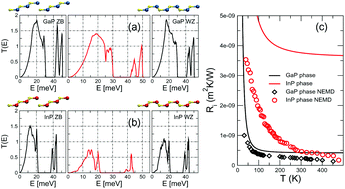Phonon transport across crystal-phase interfaces and twin boundaries in semiconducting nanowires†
Abstract
We combine state-of-the-art Green's-function methods and nonequilibrium molecular dynamics calculations to study phonon transport across the unconventional interfaces that make up crystal-phase and twinning superlattices in nanowires. We focus on two of their most paradigmatic building blocks: cubic (diamond/zinc blende) and hexagonal (lonsdaleite/wurtzite) polytypes of the same group-IV or III–V material. Specifically, we consider InP, GaP and Si, and both the twin boundaries between rotated cubic segments and the crystal-phase boundaries between different phases. We reveal the atomic-scale mechanisms that give rise to phonon scattering in these interfaces, quantify their thermal boundary resistance and illustrate the failure of common phenomenological models in predicting those features. In particular, we show that twin boundaries have a small but finite interface thermal resistance that can only be understood in terms of a fully atomistic picture.



 Please wait while we load your content...
Please wait while we load your content...